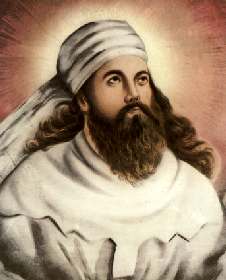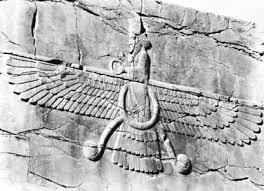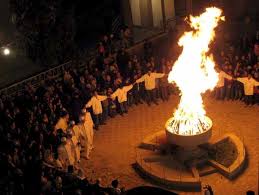For a world religion, the faith of Zoroastrians may seem small consisting of around 190,000 members. Nonetheless the historical background of Zoroastrianism is of great importance and this largely unknown Persian religion was at one- point dominant, at the height of the Achaemenid (Persian) Empire (559-530 BC).
Many of us are familiar with the likelihood of the mysterious Magi from Matthew 2 probably being Zoroastrians. Some may have scanned the commentaries for additional insight. Surely fewer people are aware that Cyrus, Darius and Artaxerxes were Zoroastrians and that this can be proven historically and archaeologically.
Interestingly, some claim that Zoroastrianism is the oldest monotheistic religion in the world. It is known for fire at places of worship and the distinctive faravahar emblem. Some argue that Zoroastrianism has significantly influenced Judaism, Christianity, and Islam.
These claims will be carefully evaluated following a section on its origins and development. After that, recommendations will be made in an effort to reach out to Zoroastrians with the gospel in a meaningful way.
Today, probably more than half of the worldwide adherents are based in India. Iran has the second largest number of Zoroastrians in the world and is where the Zoroastrian religion was founded. Consequently Zoroastrianism has taken different forms regarding some beliefs and practices in India and Iran.
There are approximately 11,000 Zoroastrians in the USA, 10,000 in Afghanistan, 5,000 in Canada, 5, 000 in Pakistan, 4, 500 in Singapore and 4,100 Zoroastrians in the UK which also hosts the World Zoroastrian Headquarters in London.
Nonetheless the influence of Zoroastrianism is far greater than the numbers might suggest. Today, there are millions globally who have adopted some form of Zoroastrian teaching. So when you speak with people from various religions it is possible, they might have been influenced by some Zoroastrian ideas.
Also Zoroastrianism is evident in various forms of classic and modern culture. Nietzsche famously wrote his atheistic apologetic ‘Thus Spoke Zarathustra’. Strauss was inspired by Nietzsche’s writing and composed his ‘Also Sprach Zarathustra’. Freddie Mercury’s family faith was Zoroastrian and in addition the make of the car ‘Mazda’ is derived from the name of the faith’s monotheistic God ‘Ahura Mazda’.
Origins and Development

At age 30 in Babylonia, Zarathustra is said to have had a vision from Vohu Manah. Note, this is akin to how Mohammed apparently received revelation from the angel Gabriel and Joseph Smith the ‘angel’ Moroni. Zoroaster is the Greek translation of Zarathustra. He was a Persian prophet and may have been a priesti.
Initially there was little interest in his religion and his cousin was his first convert ten years later. Debate continues regarding the exact beginnings. Scholars generally think Zoroaster lived around somewhere between 1500-1200BC or 600BC.ii This is debated partly to determine which religions may have influenced other ones.
According to Zarathustra.com, Zoroaster was eventually able to present his ideas to the king Vishtapsa in another land, whilst the priests and wise men grilled him concerning his new philosophy. He managed to answer the questions to gain the king’s approval who adopted his new religion and encouraged others to do the same. This was a major stepping- stone in the development of Zoroastrianism.iii
Much of the world embraced polytheism in various forms though Zoroaster was distinguished by insisting on following Ahura Mazda alone. Although Zoroastrianism is widely considered a monotheistic faith, there is also a dualistic aspect with Angra Mainyu being equally powerful but evil, and totally opposite to Ahura Mazda in character. Central to Zoroastrianism is the awareness of the inward ethical dualism and commitment to following the wise and right path.iv

Concerning creation, Ahura Mazda purportedly made the heavenly and terrestrial worlds to enable him to oppose Angra Mainyu.v. The concept is such that Ahura Mazda created a perfect and good world, yet Angra Mainyu corrupted it. For Zoroastrians, humans are essentially good and there is no concept of original sin.vi
The ongoing power struggle between Ahura Mazda and Angra Mainyu was equally pitted until Zarathustra arrived. At 1000- year intervals ‘saviours’ are born and successively destroy a part of the evil creation until the third and final one resurrects the dead and introduces the last judgement.vii
On the day of judgement, on the 3rd/4th day after death, the soul crosses a bridge and the good deeds are weighed against the bad ones.viii It is therefore essential for Zoroastrians to take personal responsibility for what is good and strive to reject that which is morally wrong.
The sacred scriptures of Zoroastrians are known as the Avesta and the Yasna is the central and most important section. Inside the Yasna there are five hymns with a more ancient dialect than the rest of the Avesta, which are widely regarded as being composed by Zoroaster.ix

The symbolism of fire is integral to Zoroastrian beliefs and practise and fire is kept alight continually in Zoroastrian places of worship. Zoroastrians also pray in seclusion in front of other forms of light including the sun, moon, candle or even an electric light though the purpose is to symbolise the creator, not to worship the fire itself.x
Other lesser known concepts but of importance to Zoroastrianism are gender equality in domestic and religious life, a care and concern for the environment and commitment to hard work, shunning slothfulness with a view to be able to contribute towards charitable causes.
Is Zoroastrianism the oldest monotheistic religion, influencing Judaism and Christianity?
To respond to this question we need to establish when Zoroaster lived, when the Avesta was written and whether the authors were reliable.
Zoroaster probably lived before 600BC though he could possibly have lived around 1200; a less scholarly and more marginal view, would say Zoroaster was around as early as 1700BC. It is worth considering that scholars cannot actually determine the century that Zoroaster was born in.xi
It is also worth noting that Zoroastrianism was the dominant religion in the ruling class of the Persian Empire from the sixth to fourth century BCxii and that was also the period when it was most influential.
Even if Zoroaster was around as early as 1700BC, Moses wrote of historical events as far back as 4000BC and the majority view of scholars both liberal and conservative is that Moses wrote the Torah between 1446 and 1406BC.xiii
Moses predates Zarathustra
The earliest written accounts of Zoroastrianism were as late as the fourth century AD and the oldest manuscript of the Avesta is from the fourteenth century AD. The addition to the Torah being written between 1446 and 1406 BC. The Septuagint was written approximately 300 BC.
The Dead Sea Scrolls range from the third century BC until AD 70. All of the New Testament books were written before AD 96 and there is an abundance of early manuscripts in Greek and other languages.
Judaism and Christianity are strictly monotheistic. Zoroastrianism is monotheistic/dualistic since, although only one Deity is worshipped, Ahura Mazda is said to be equal to Angra Mainyu. Zoroastrianism is therefore arguably polytheistic. Conversely the Bible affirms that Satan is real and utterly evil but is a created being and nowhere near as powerful, or knowledgeable and is not omnipresent.
The Avesta was authored by Zarathustra whereas the Bible was written by around 40 authors who come from a range of locations and cultural backgrounds. Yet the Bible is a unit and fits together perfectly. It is difficult to ascertain if or how Zoroastrianism influenced Islam though it is noticeable that each faith had a single founder who had respective visions and authored their books.
Building Bridges and Reaching Zoroastrians
In the introduction, a few Persian kings who were Zoroastrian rulers, were mentioned. One way to build a bridge could be to start a conversation about Cyrus. He is mentioned in a favourable light in the Scriptures. Isaiah prophesied about him (Isaiah 44:28-45-6) and he allowed the Jewish people in Babylon to return to their homeland (2 Chronicles 36:22-23; Ezra 1:1-4).
Similarly one could mention Artaxerxes who kindly gave Nehemiah the cup bearer permission to go to Jerusalem to rebuild it (Nehemiah 2:8). This could be developed by demonstrating this is supported archaeologically.
In Room 52 of the British Museum you can view the Cyrus cylinder enabling people from Babylon to go to their homelands. It is also possible to see Artaxerxes drinking vessels that are marked in cuneiform script which might have been the very ones that Nehemiah may have used to serve King Artaxerxes.
I have only met three Zoroastrians and I think it is helpful to remember that we need to be careful of following a textbook approach. Instead find a bit about them and what they believe in a friendly and genuine way. The first chap did not speak a huge amount of English. At first it took me a while to figure out what he actually believed, but we found that we had quite a bit in common.
The second, a lady, came from a Zoroastrian background and evidently enjoyed being a part of that community. However, whilst holding on to that identity she was interested in other religions. It certainly wouldn’t have surprised me if she had incorporated a few ideas from various religions.
The third person I met only briefly, coming from a Zoroastrian background and who is in full time Christian ministry. He kindly gave me some helpful suggestions. He stressed the importance that is placed on Zoroastrianism being the oldest monotheistic religion.
You may challenge a Zoroastrian in a gracious way whether that is actually the case. You may also challenge what certainty or assurance they have for the next life. They will then see why the gospel is important and what is being presented.
Secondly that individual noted Zoroastrians are familiar with rituals, traditions and ceremonies, so it would be worth exploring what that means to them. You may then share why you do what you do in the context of church meetings and also in your personal walk with the Lord.
The Christian Connection
Thirdly, that believer mentioned the importance of identity for the Zoroastrian including race, community, and family. This means that in our outreach to Zoroastrians we must deal with questions around identity issues. This needs to encompass a Christian’s identity in Christ and also what it means to be a part of the church community.
Another means of building a bridge is to discuss the magi, who were probably Zoroastrian worshippers who brought gold, frankincense, and myrrh. We are undoubtedly more interested in who they were rather than how many there were!
We find those individuals intriguing and programs are presented trying to uncover more about them or their culture; carols include them, and they are important characters in Matthew’s Gospel. Why did they bring those particular gifts to Jesus? Gold spoke of his kingship, frankincense his priesthood and deity and myrrh spoke of his sacrificial death, needed to atone for the sins of the world.
Zoroastrians are concerned that at the last judgement their deeds are weighed in a similar concept to that of Islam. The good deeds are meant to outweigh the bad ones. You could therefore ask them how good they have to be and how many deeds would need to be done to ensure a favourable afterlife? This will uncover that we have done things we regret and that we need forgiveness.
We can explain that when we trust in the Lord Jesus, it is not a case of what we have to do but what God has done. Atonement for sins has been made through the Lord Jesus being sacrificed as a substitute to save us from hell and from our sins and only He can put things right that we could not put right by ourselves.
Zoroastrianism is yet another works- based religion. Explain that grace means ‘free unmerited favour’ and that this is vastly different than following a prescribed set of rules, rituals, and routine ceremonies. We can never generate enough merit to pass through safely at the last judgement, but we can be assured of salvation if we turn to the Lord and trust in Him.
You may like this article on Grace and Legalism
References:
i Complied by Mark Water AMG’s encyclopaedia of world religions, cults and the occult (AMG; 2006, Chattanooga) p462
ii Ibid, 462
iii https://www.zarathushtra.com/z/life/index.htm
iv https://www.w-z-o.org/zoroasters-message/
v Christopher Partridge: General Editor The New Lion Handbook The World’s Religions (Lion Hudson; 2005, Oxford), p247
vi Water, p470
vii Partridge, 248
viii https://www.w-z-o.org/zoroasters-message/
ix Josh McDowell & Don Stewart Concise Guide to Today’s Religions (Scripture Press; 1992, Bucks), p342
x https://www.w-z-o.org/the-symbolism-of-fire-prayers/
xi John Oakes Does Zoroastrianism predate Christianity and is the idea that Christianity borrowed the resurrection of Jesus from the religion believable? April 24th, 2013 https://evidenceforchristianity.org/does-zoroastrianism-predate-christianity-and-is-the-idea-that-christianity-borrowed-the-resurrection-of-jesus-from-the-religion-believable/
xii Ibid
xiii Dr Carl Broggi Chapter 15World Religions and Cults: Zoroastrianism October 12th, 2018 https://answersingenesis.org/world-religions/world-religions-and-cults-zoroastrianism/

